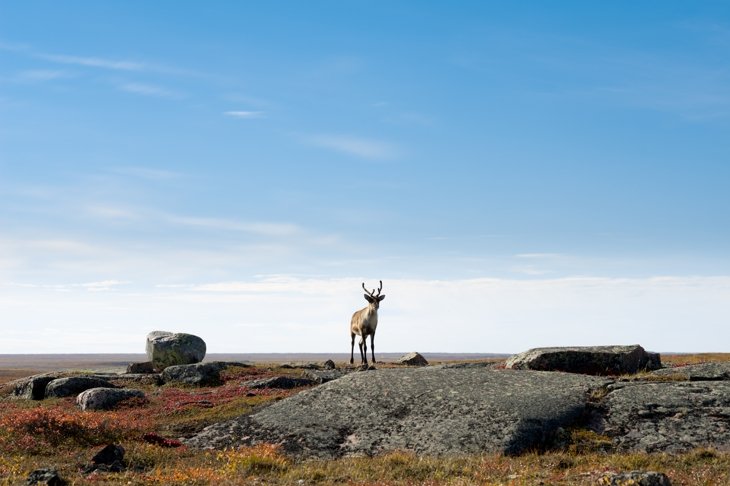
Canada\’s caribou aren\’t doing so well. Here\’s why you should care—and how you can help ensure these unique animals stick around.
In April 2017, a citizen-based committee, the Upper Clearwater Referral Group (UCRG), filed a legal application with the Ministry of the Environment and Climate Change to request an emergency stop-work order for the ongoing clear-cutting in the critical caribou habitat adjacent to Wells Gray Provincial Park in east-central BC. The application, yet to be acted upon by government officials, is the last chance to save the local herd of endangered southern mountain caribou.
The case of the southern mountain caribou
The globally unique southern mountain caribou species that ranges throughout the interior wet belt of BC is declining rapidly. These animals have wide, furry hooves to tread over deep snow. For nearly half a year, their diet is almost exclusively arboreal lichen, found at lower and higher elevations.
Listed as threatened under the federal Species at Risk Act and as endangered by the Committee of the Status of Endangered Species in Canada (COSEWIC), there are approximately 1,200 animals left in BC.
Wells Gray Provincial Park provides sanctuary to the world’s second largest population of southern mountain caribou. The southern Wells Gray herd, for which the petition has been submitted, numbers 121 individuals, less than half of 325 in 2002.
“The caribou population here has been dropping dramatically since 2002 because of logging adjacent to the park,” explains Trevor Goward, a local resident, lichenologist and curator of lichens at the University of British Columbia, and UCRG spokesperson. “In 2014, the federal government designated areas in the Upper Clearwater Valley as critical habitat and thus to remain untouched to ensure the caribou survives.”
However, in 2016, logging permits were issued for the same areas by the provincial government, which will likely cause the herd to decline further. The most recent harvesting happened in May 2017.
Logging in high elevation areas depletes the old-growth forest where arboreal lichens grow. “Lichens become more abundant as the forest ages,” says Goward. It takes up to 150 years to have another old-growth forest that supports lichen.
Logging in valley bottoms causes deer and moose to advance, which increases the likelihood of encountering predators such as wolves. “Deer can run from predators, moose can fight, but the caribou, which usually hide in the forests away from danger, have nowhere to go. They are sentenced to die,” says Goward.
Threats
None of the existing caribou in Canada are doing well. “Each type is distinct from each other, but latest assessments showed that all types are at some risk of extinction,” says Justina Ray, PhD, co-chair of the Terrestrial Mammal Subcommittee with COSEWIC, and president of the Wildlife Conservation Society Canada.
“The mountain caribou in western Canada have deteriorated in the last 10 years, but the southern mountain caribou unit are among the worst in the country,” she explains. Populations are dwindling and becoming increasingly isolated from each other. Human activity is the main cause of the profound habitat changes they are experiencing.
Mountain caribou face constantly growing threats:
- increasing industrial developments that require land clearing and access roads (logging, mining, and oil and gas extraction)
- large cumulative footprint brings about ecosystem changes favouring other ungulate species and the predators of caribou
- more frequent and larger wildfires in forested areas
- insect outbreaks due to climate change, and subsequent salvage logging
- backcountry recreational activities, especially snowmobiling
What the future holds
Measures implemented so far include predation control, prey reduction, maternal penning, captive breeding, and relocation.
“Killing wolves is cruel and an unsustainable solution unless the logging stops,” says Goward. Ray agrees it is an example of “intensive management when things have gone too far.” It’s a drastic measure that may stabilize herds, but is unsustainable without habitat regeneration at the same time, which takes decades.
Penning the caribou to allow safe birthing grounds has had some promising results, but it might not apply to all of the caribou units. Relocation and captive breeding do not always work.
“With their habitat changing dramatically, and without these intensive measures, the caribou will not survive,” explains Ray. And they will not, unless forest harvesting and other industrial developments are reduced as well.
Those changes must be made now, if caribou are to live.
Canada’s caribou—from millions to a handful
Once the most abundant mammal in North America, all types of caribou are now in peril. The iconic Arctic herds of caribou are down to less than half, with declines of 95 and 98 percent respectively in some populations. Other populations across the country are dwindling rapidly. This is a direct effect of climate change and insufficient action in protecting their habitat, mostly from human industrial activities.
How you can help
Stay informed:
- Caribou and the North: A Shared Future
by Monte Hummel and Justina C. Ray (Dundurn, 2008)
- Wildlife Conservation Society wcscanada.org
- Death by a Thousand Clearcuts 1000clearcuts.ca
- World Wildlife Fund (Arctic, wildlife, caribou) wwf.ca
Donate:
- Wildlife Conservation Society Canada wcscanada.org
- World Wildlife Fund Canada wwf.ca
Buy recycled:
- paper products and reclaimed wood products
Avoid:
- backcountry recreational activities in caribou habitat

